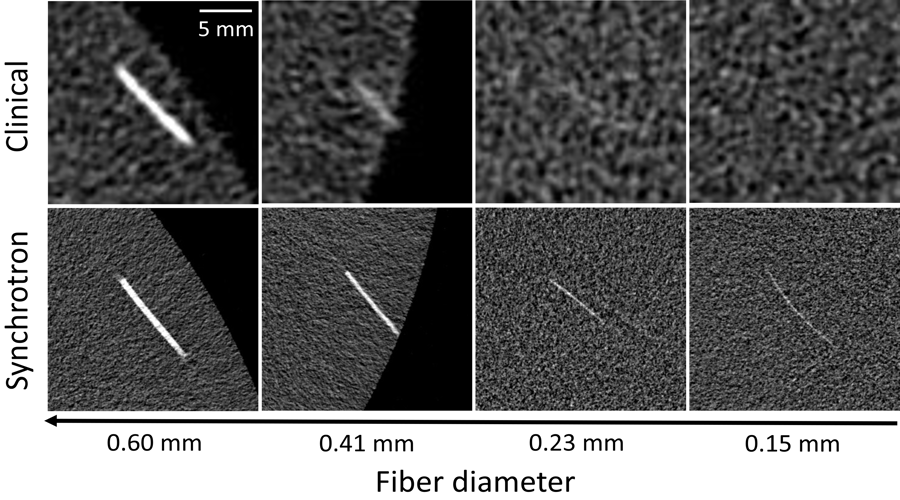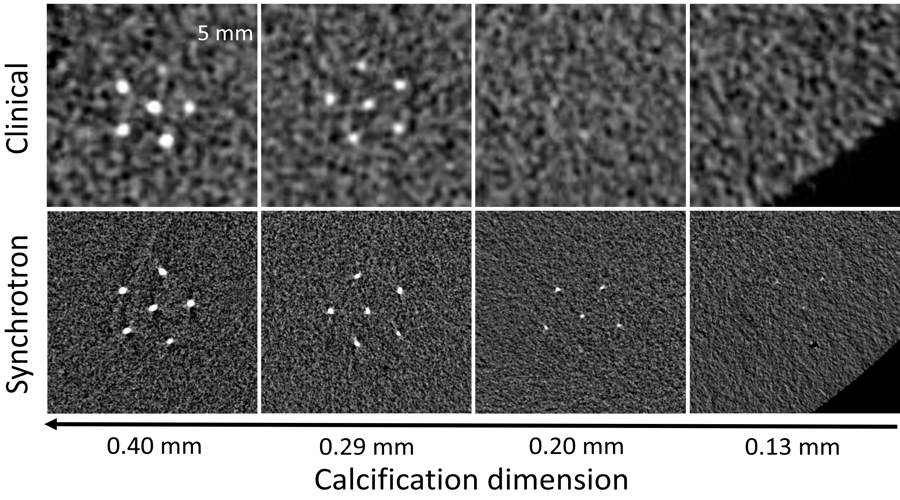PhD Top Stories
Luca Brombal
Breast Computed Tomography with synchrotron radiation: a comparison with clinics
Doctoral Programme in Physics
Breast cancer is the leading cause of cancer death in women worldwide, and the success of its treatment is heavily dependent on early diagnosis. In this context, 2D digital mammography is the reference diagnostic tool, and its wide use for screening has significantly reduced breast cancer mortality. Anyhow, mammography has some intrinsic limitations, often bringing to sub-optimal sensitivity and specificity, and to severe patient discomfort. To overcome these limitations, a great effort has been devoted in the last decade to the development of Breast Computed Tomography (BCT), which can provide fully 3D images of the breast, avoiding both tissue superposition inherent to 2D imaging, and breast compression. In this field the main challenge is to combine soft-tissue differentiation (i.e., high signal-to-noise ratio) and small calcification detection (i.e., high spatial resolution) while delivering a low X-ray radiation dose. Given the difficulty of meeting all these requirements, the transition of BCT to clinics has been relatively slow and, at present, only two commercial scanners are available and few (less than 10) hospitals worldwide have a BCT machine. In this framework, the SYRMA-3D (SYnchrotron Radiation MAmmography) project aims at developing the world’s first phase-contrast synchrotron-radiation based BCT system in Trieste. SYRMA-3D is funded by the National Institute of Nuclear Physics (INFN) and Elettra Sincrotrone S.C.p.A., involving many researchers of the Trieste University. Compared to conventional scanners, where the image contrast derives from the attenuation of X-rays, the key novelty of the project is the capability of detecting X-ray refraction. This effect is in principle much stronger than attenuation, allowing to dramatically increase the visibility of structures within the breast. Among the methods allowing for refraction detection, the so-called propagation-based technique is arguably the most widely used. This technique has strict requirements in terms of X-ray source characteristics (i.e. high spatial coherence), which are met at synchrotron facilities. Additionally, synchrotron radiation has other peculiar features (e.g., monochromaticity, laminar beam) allowing for a more efficient dose delivery.

Figure 1 - Visibility of fibers as a function of their diameter.
In this context, a first-of-its-kind quantitative comparison study between a conventional BCT scanner and the under-development synchrotron BCT setup has been performed. This investigation aims at assessing the diagnostic potential of phase-contrast and its benefits compared to conventional BCT. The study is based on a custom-made phantom mimicking an actual breast shape and composition. The phantom embeds a variety of targets simulating tumor masses, fibroglandular details and microcalcification clusters. Thanks to the collaboration with the Radboud University Medical Center (Nijmegen, The Netherlands), the sample was scanned with a hospital BCT system and clinical settings, resulting in a mean glandular dose of 6 mGy. The same phantom has been subsequently scanned in a patient-dedicated room at the SYRMEP beamline at Elettra, delivering the same radiation dose. Some of the imaging results are shown in the reported figures. Specifically, Fig. 1 shows the visibility comparison on thin fibers as a function of their diameter. From the images is clear that synchrotron largely outperforms the clinical system, allowing to distinguish fibers below 0.15 mm of diameter, whereas the clinical system’s limit is around 0.3 mm. Similar conclusions can be drown from Fig. 2, where the comparison involves clusters of calcifications of different diameters. Of note, the detection of these features is of great clinical relevance as they may signal a malignant lesion.

Figure 2 - Visibility of microcalcifications as a function of their dimension.
Notwithstanding the fact that radiological applications in synchrotron cannot reach a wide population due to the high infrastructural and economical costs, these studies can provide benchmarking results, effectively defining the upper limit in terms of achievable image quality. It is the author’s belief that a wider diffusion of such applications is key for reaching the critical mass of experienced scientists and medical doctors which is needed to trigger the long-anticipated transition of phase contrast from synchrotrons to hospitals, ultimately bringing to a better X-ray diagnostic available to a large number of people.
Authors and affiliations
Luca Brombal1,2, Fulvia Arfelli11,2, Pasquale Delogu3,4, Sandro Donato1,2, Giovanni Mettivier5,6, Koen Michielsen7, Piernicola Oliva8,9, Angelo Taibi10,11, Ioannis Sechopoulos7,12, Renata Longo1,2 & Christian Fedon7,22INFN Sezione di Trieste, Via A. Valerio 2, 34127 Trieste, Italy.
3Dipartimento di Scienze Fisiche, della Terra e Dell’Ambiente, Università di Siena, Strada Laterina 8, 53100 Siena, Italy.
4INFN Sezione di Pisa, Largo Bruno Pontecorvo 3, 56127 Pisa, Italy.
5Dipartimento di Fisica, Università di Napoli Federico II, Via Cinthia 21, 80126 Napoli, Italy.
6INFN Sezione di Napoli, Via Cinthia 21, 80126 Napoli, Italy.
7Department of Radiology and Nuclear Medicine, Radboud University Medical Center, 6500 HB, Nijmegen, The Netherlands.
8Dipartimento di Chimica e Farmacia, Università di Sassari, Via F. Muroni 23, 07100 Sassari, Italy.
9INFN Sezione di Cagliari, Strada provinciale per Sestu, 09042 Monserrato (CA), Italy.
10Department di Fisica e Scienze della Terra, Università di Ferrara, Via G. Saragat 1, 44122 Ferrara, Italy.
11INFN Sezione di Ferrara, via G. Saragat 1, 44122 Ferrara, Italy.
12Dutch Expert Center for Screening (LRCB), 6503 GJ, Nijmegen, The Netherlands.
Contacts
Luca Brombal, email: lbrombal@units.itReference
Luca Brombal, Fulvia Arfelli, Pasquale Delogu, Sandro Donato, Giovanni Mettivier, Koen Michielsen, Piernicola Oliva, Angelo Taibi, Ioannis Sechopoulos, Renata Longo, Christian FedonImage quality comparison between a phase-contrast synchrotron radiation breast CT and a clinical breast CT: a phantom based study
Scientific Reports 9, 17778 (2019)
DOI: 10.1038/s41598-019-54131-zj
Informazioni aggiornate al: 22.6.2020 alle ore 19:04
Contact: Webmaster - Università di Trieste pagina curata da: Research Doctorate

Piazzale Europa, 1 - 34127 - Trieste, Italia -
Tel. +39 040 558 7111 - P.IVA 00211830328
C.F. 80013890324 - P.E.C. ateneo@pec.units.it


